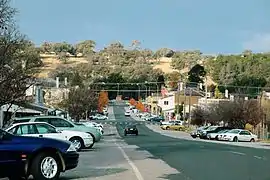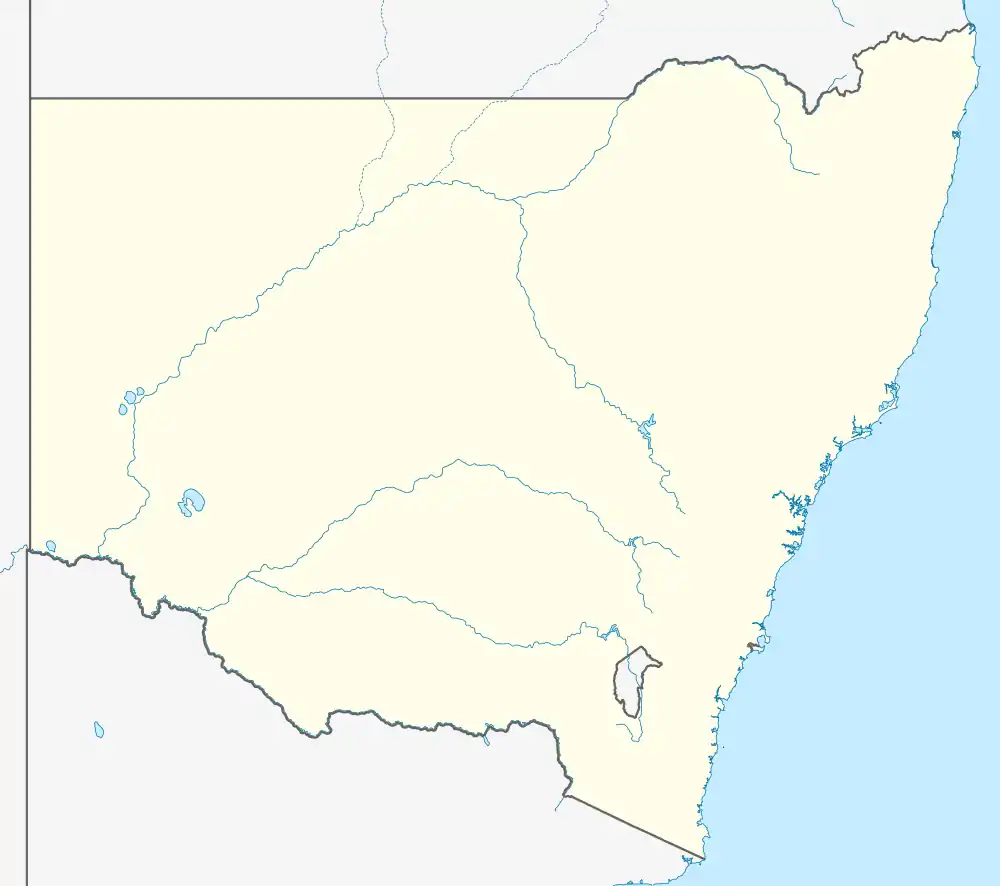Molong
Molong is a small town in the Central West region of New South Wales, Australia, in Cabonne Shire.
| Molong New South Wales | |||||||||
|---|---|---|---|---|---|---|---|---|---|
 The main shopping area of Molong, Bank Street | |||||||||
 Molong | |||||||||
| Coordinates | 33°06′0″S 148°51′0″E | ||||||||
| Population | 1,674 (2016 census)[1] | ||||||||
| Established | 1849 | ||||||||
| Postcode(s) | 2866 | ||||||||
| Elevation | 565 m (1,854 ft) | ||||||||
| Location |
| ||||||||
| LGA(s) | Cabonne Shire Council | ||||||||
| State electorate(s) | Orange | ||||||||
| Federal Division(s) | Calare | ||||||||
| |||||||||
History
The name Molong comes from the Aboriginal word for 'all rocks'.[2]
William Lee of Kelso is said to have had cattle in the area by 1819. He later held property just north of present Molong, around Larras Lee. In 1826, a military and police outpost was established at Molong, on Governor Darling's orders, as a step in opening up the government stock reserve west of the Macquarie River for settlement. For its first twenty years the settlement was at a site approximately 1.5km east of the current location. The present village of Molong was officially gazetted in March 1849.[3][4] In 1845, Copper was discovered at Copper Hill, just north of the town.[4]
The Historical Museum is housed in a former hotel (1856), built by rubble-mason James Mortal, who sold it in 1861 to John Smith of Gamboola. Smith let the building to a series of publicans and it later became the residence and surgery for a series of doctors. The Historical Society acquired it for use as a museum, in 1969, with help from the Molong Shire Council.
Heritage listings
Molong has a number of heritage-listed sites, including:
- Main Western railway: Molong railway station[5]
- 3 km SE of Molong Yuranigh Road: Grave of Yuranigh[6]
Geography
Molong is located on the Mitchell Highway about 300 kilometres west of Sydney and about 30 kilometres from the city of Orange, and an elevation of 529 metres above sea level. At the 2016 census, Molong had a population of 1,674 people.[1] Charles Sturt visited Molong in 1828. Molong was the site of an early copper mine in Australia, located at Copper Hill just outside Molong.
The railway from Sydney reached Molong in 1886; it was later extended to Parkes.[7] A branch railway to Dubbo was opened in 1925 and closed in 1987.[8]
Education
- Molong Central School
- St Joseph's Catholic Schools
References
- Australian Bureau of Statistics (27 June 2017). "Molong (Urban Centre/Locality)". 2016 Census QuickStats. Retrieved 30 April 2019.

- "Molong". Geographical Names Register (GNR) of NSW. Geographical Names Board of New South Wales. Retrieved 31 October 2009.

- "MOLONG". New South Wales Government Gazette (44). New South Wales, Australia. 30 March 1849. p. 558. Retrieved 30 April 2019 – via National Library of Australia.
- "Molong - Gold Trails". Gold Trails Inc. Retrieved 30 April 2019.
- "Molong Railway Station and yard group". New South Wales State Heritage Register. Office of Environment and Heritage. H01196. Retrieved 18 May 2018.
- "Grave of Yuranigh". New South Wales State Heritage Register. Office of Environment and Heritage. H01713. Retrieved 18 May 2018.
- "Broken Hill Line". www.nswrail.net. Retrieved 20 January 2007.
- "Molong - Dubbo Line". www.nswrail.net. Retrieved 20 January 2007.
External links
![]() Media related to Molong at Wikimedia Commons
Media related to Molong at Wikimedia Commons
- Molong on the Orange Town & Around website